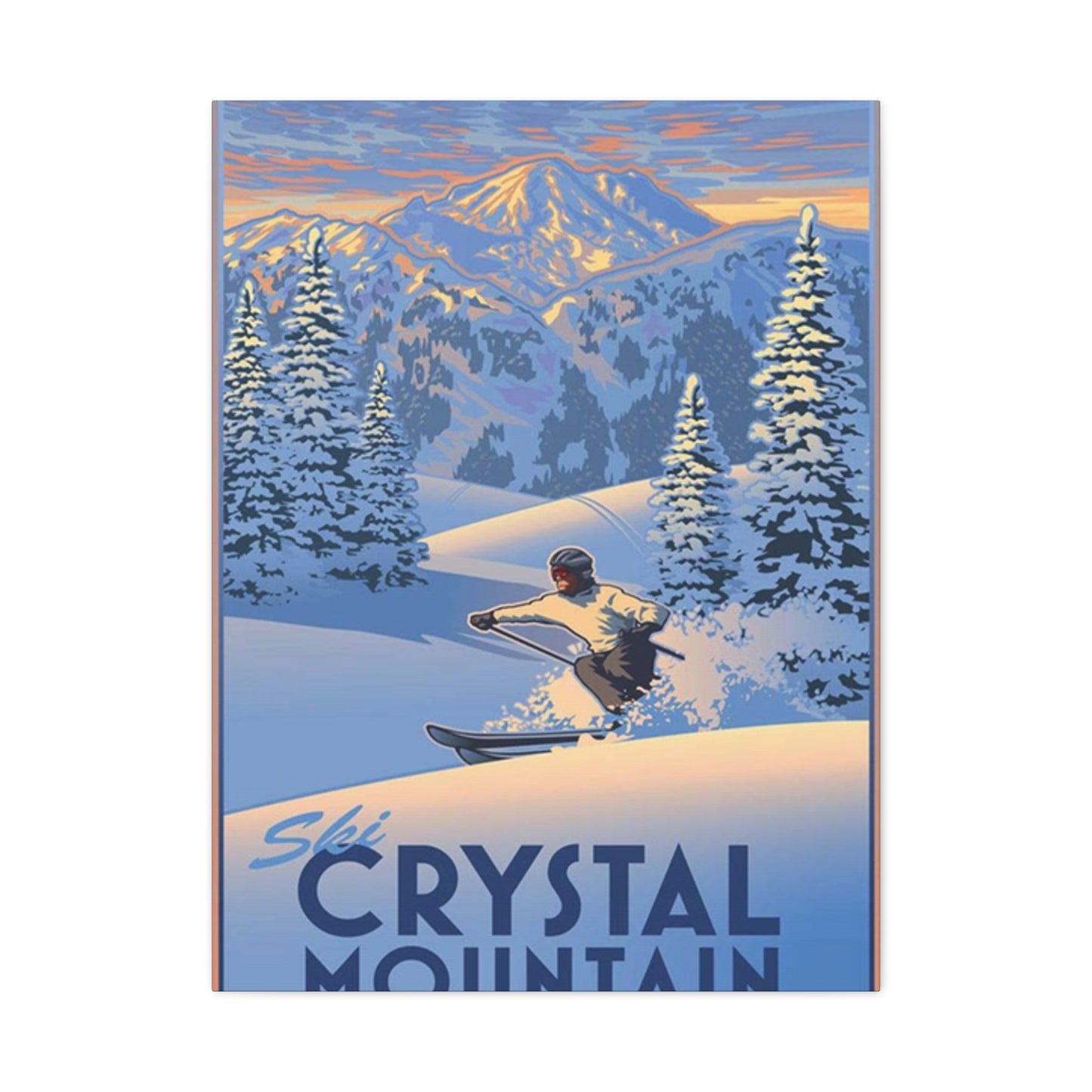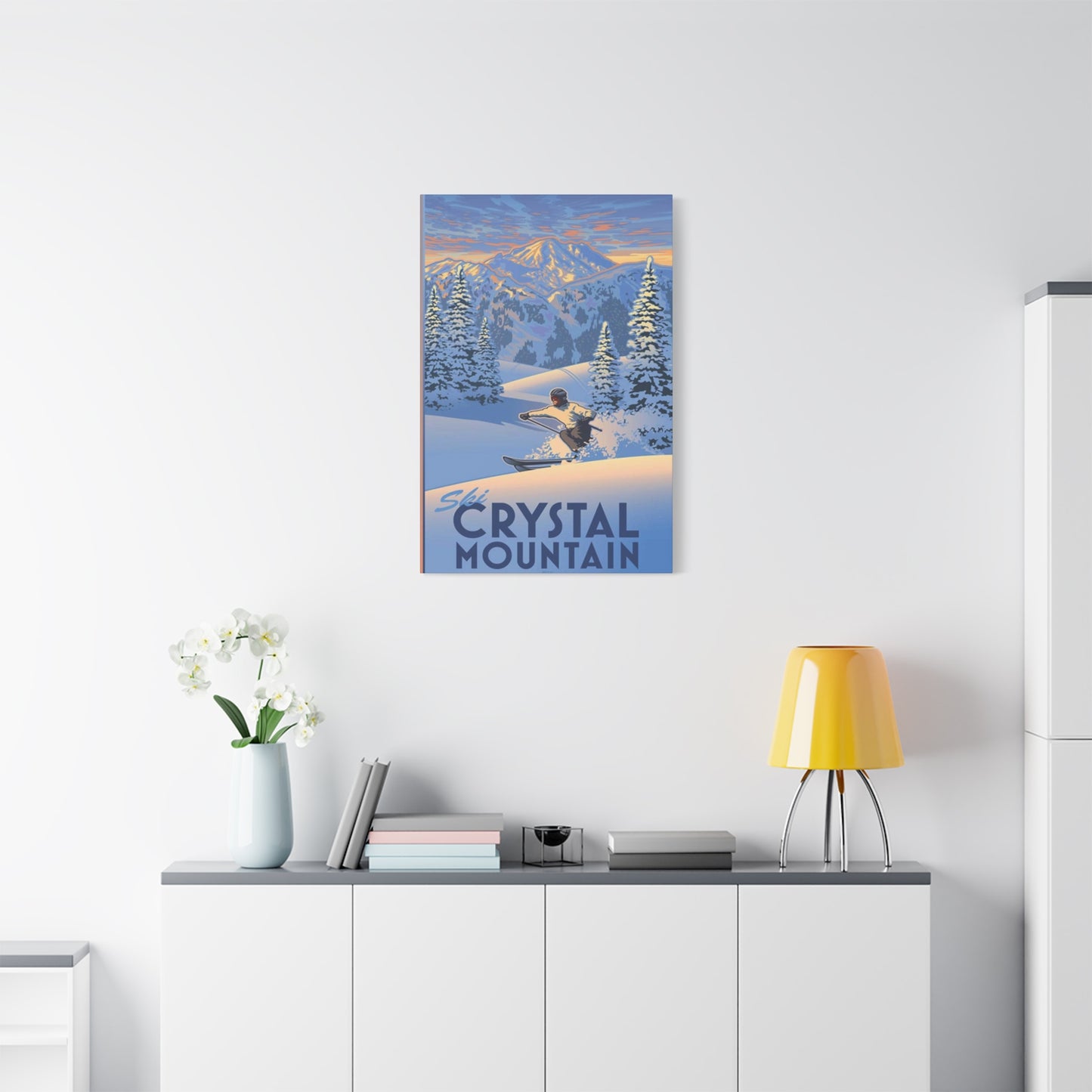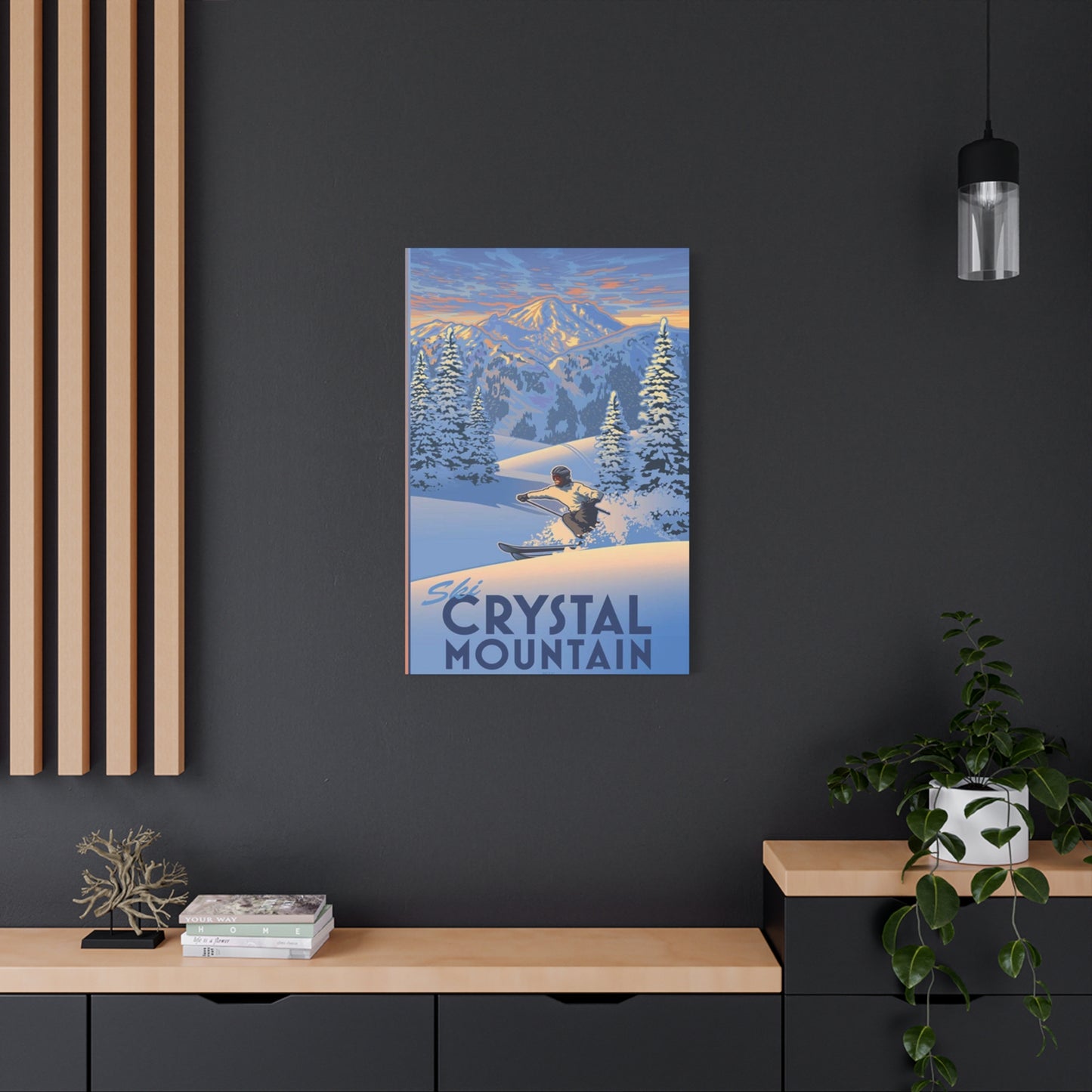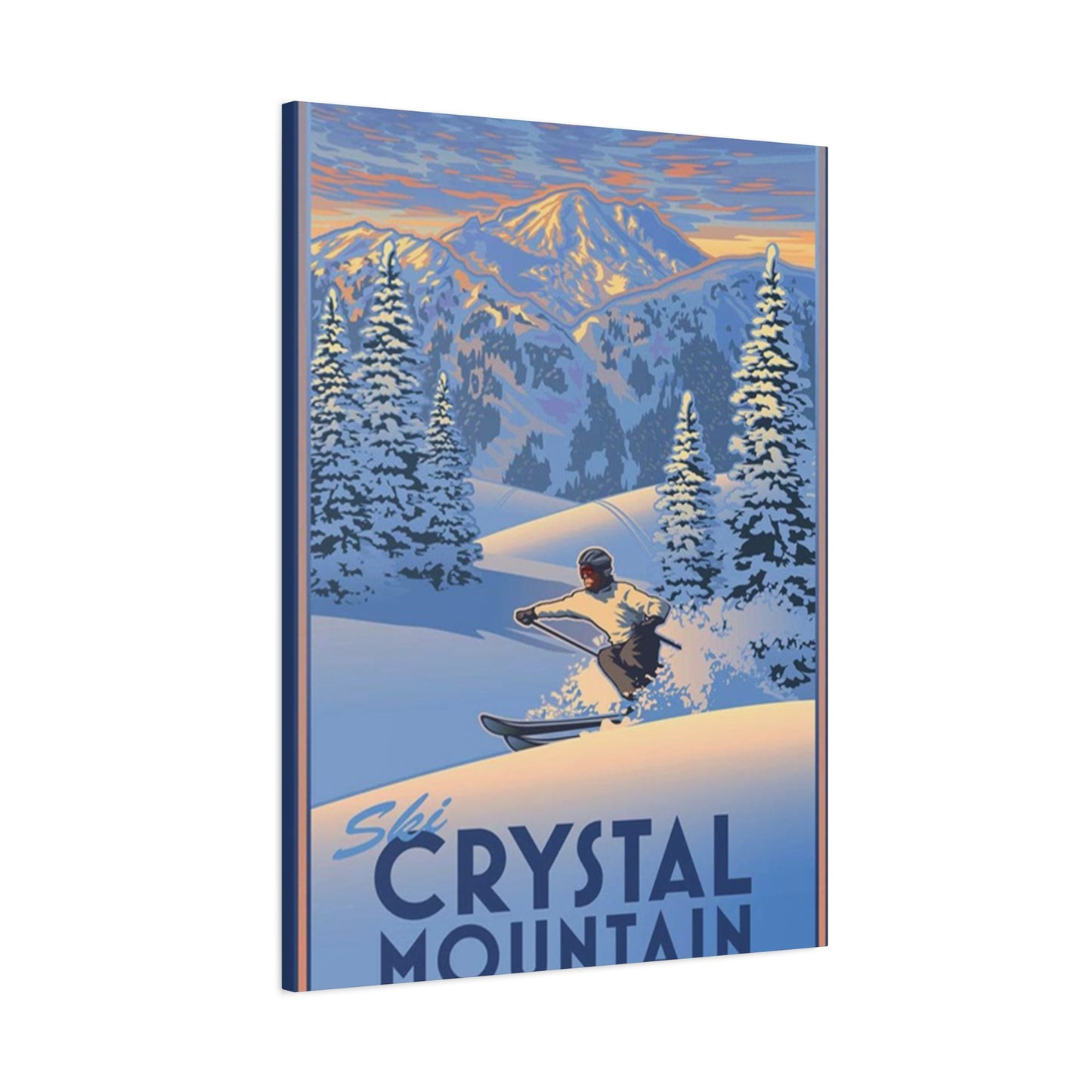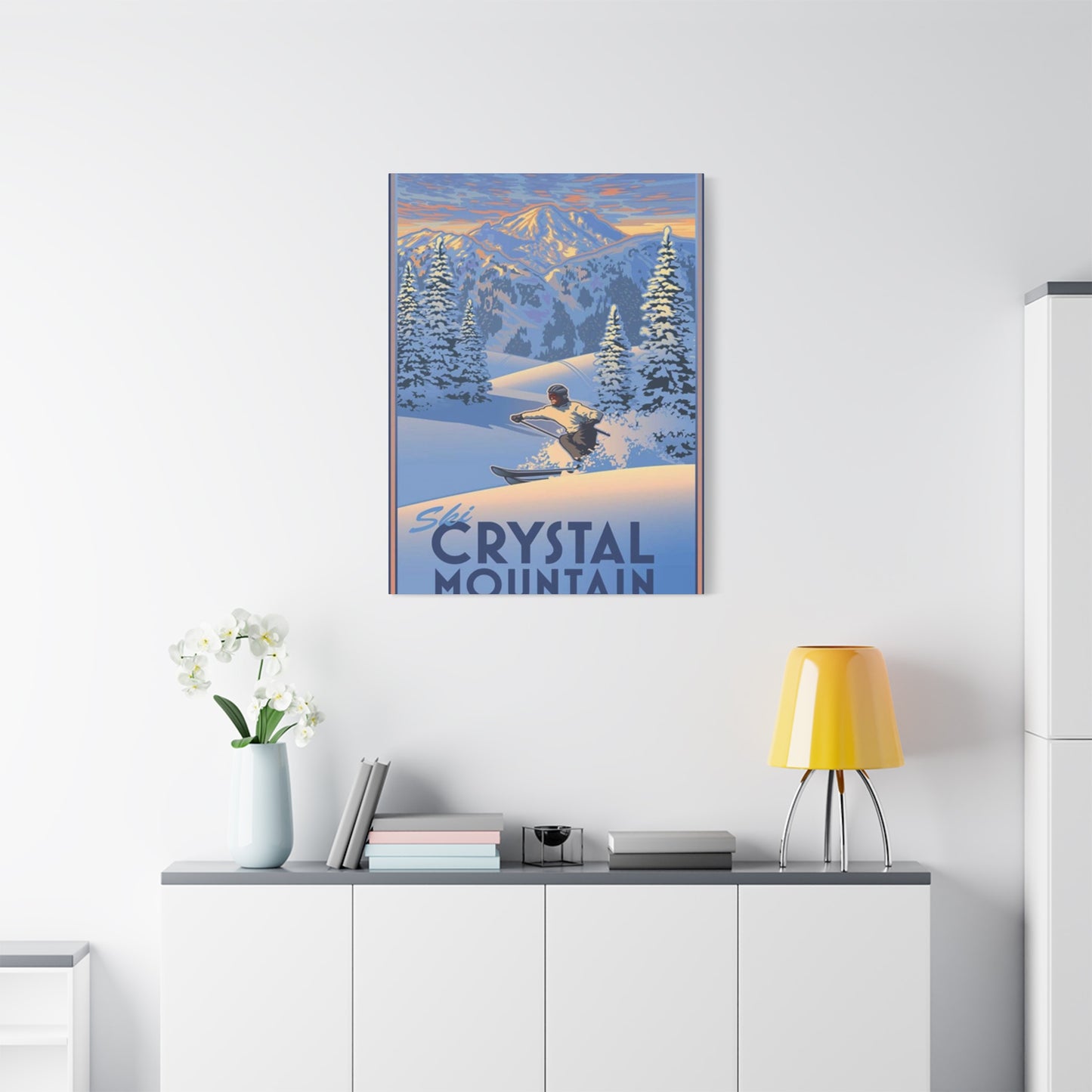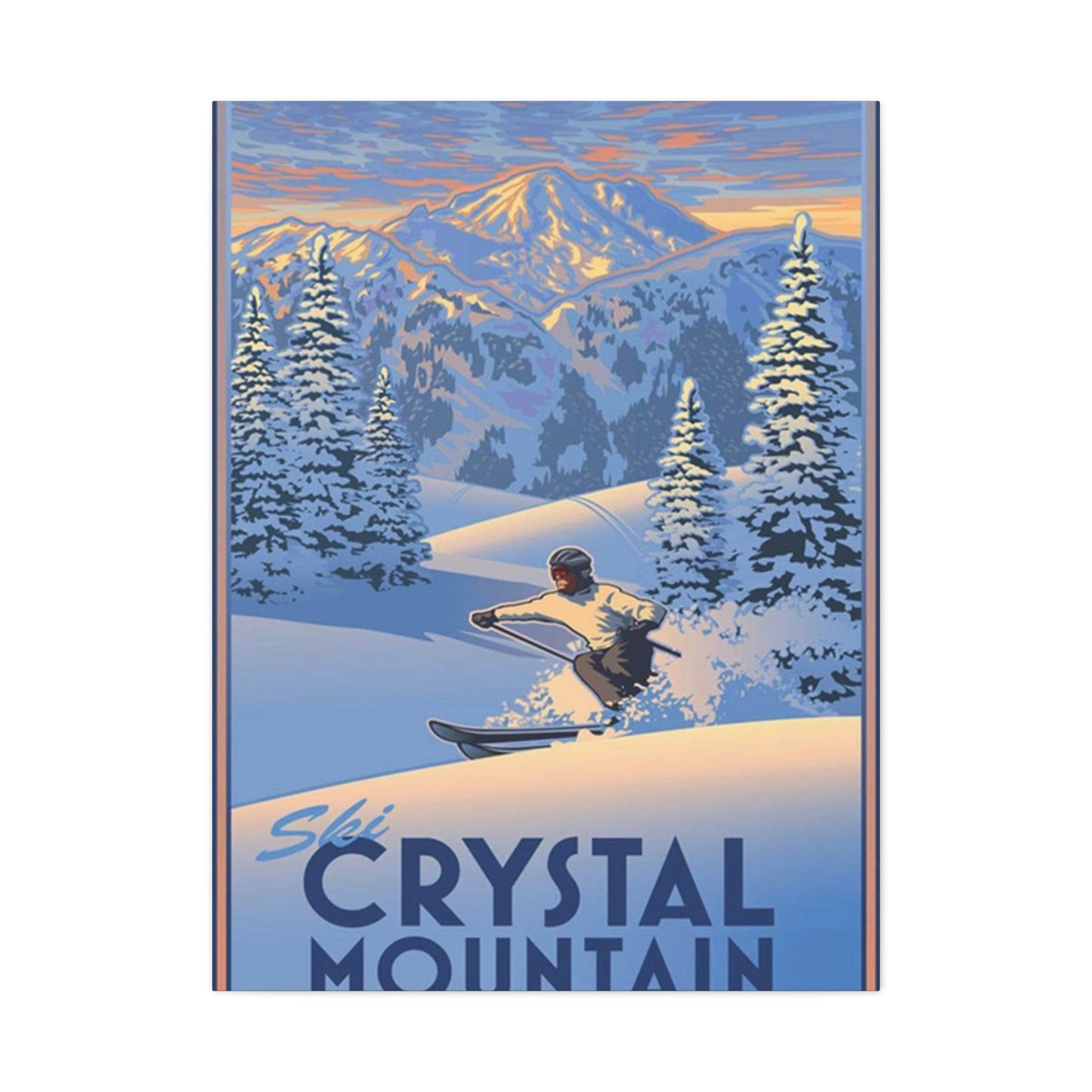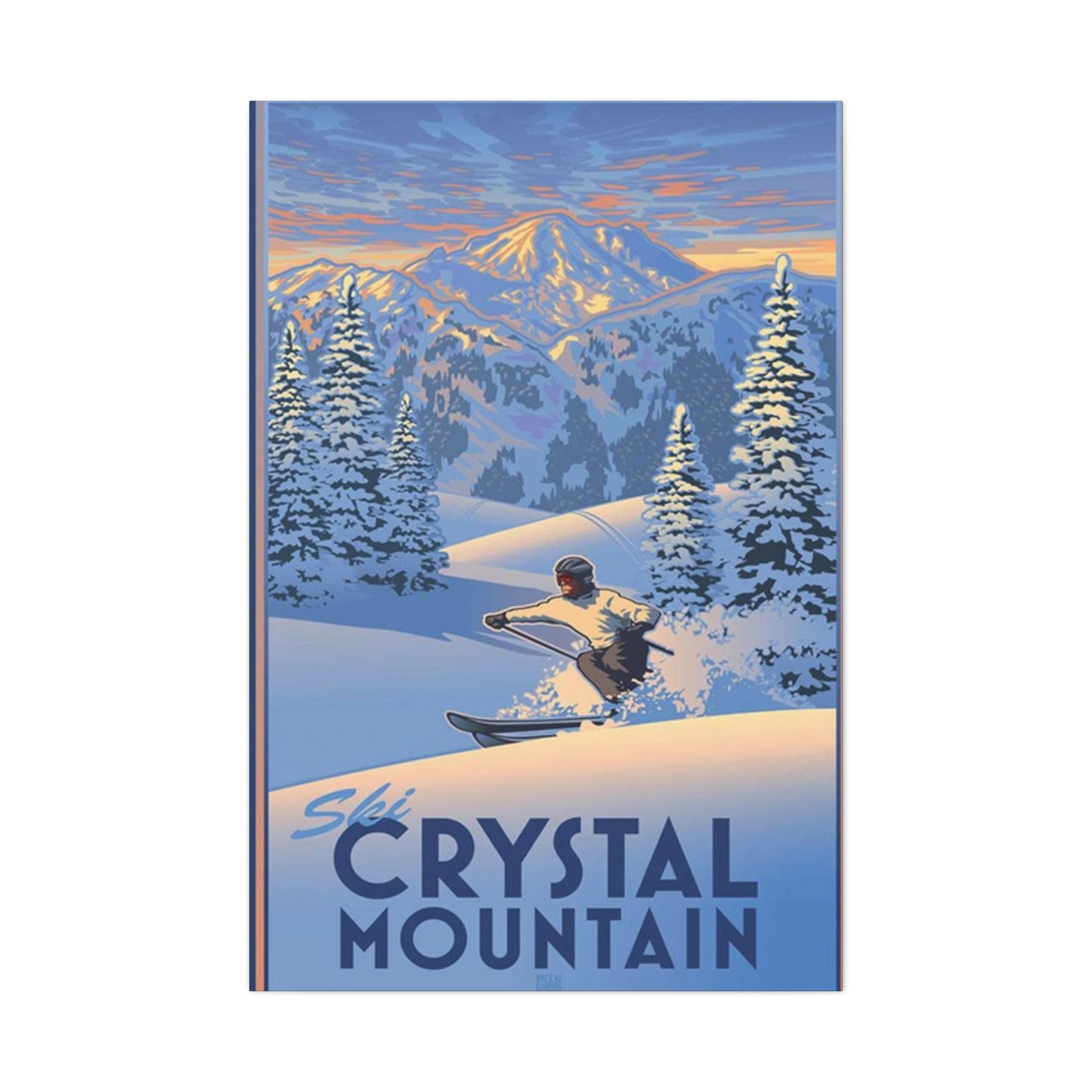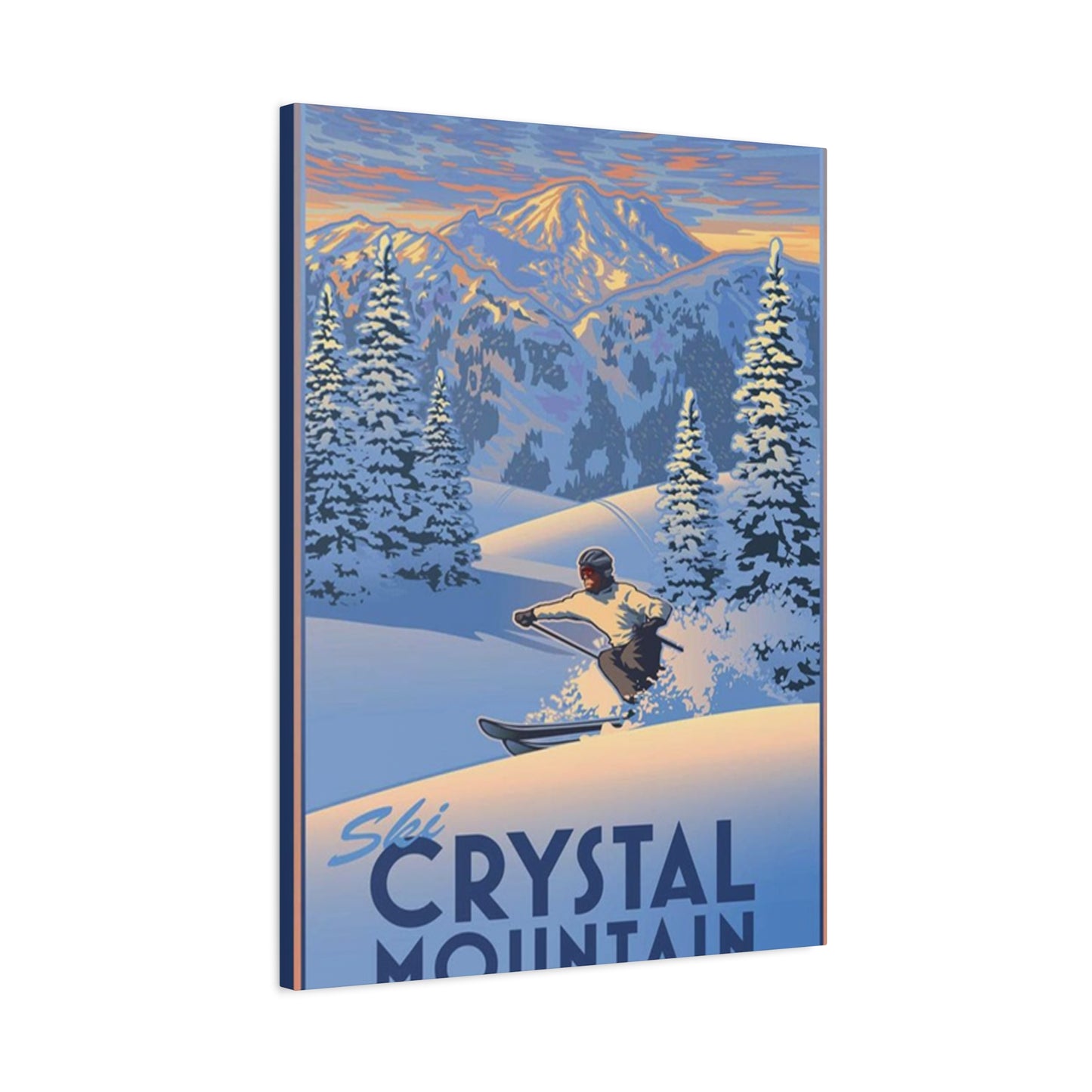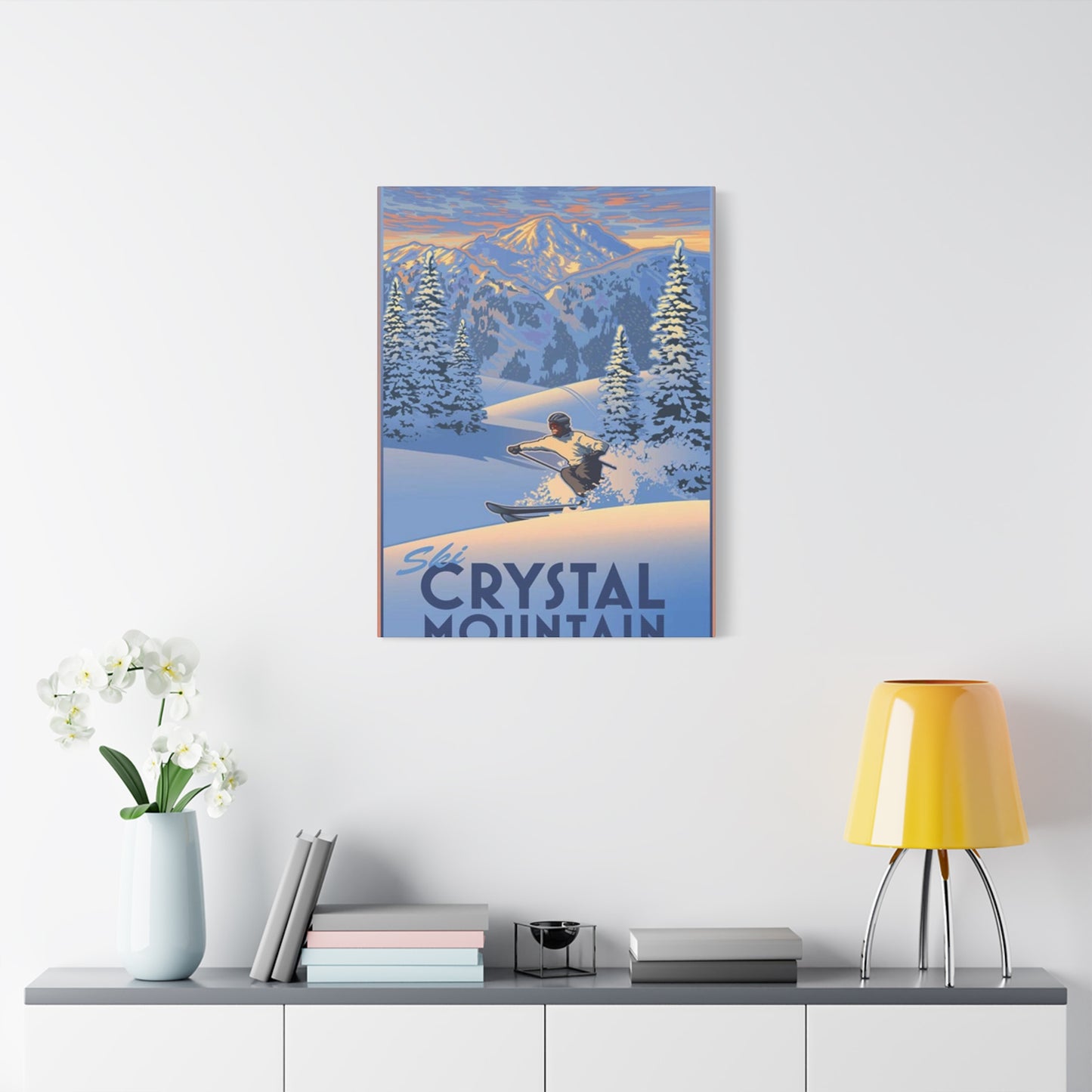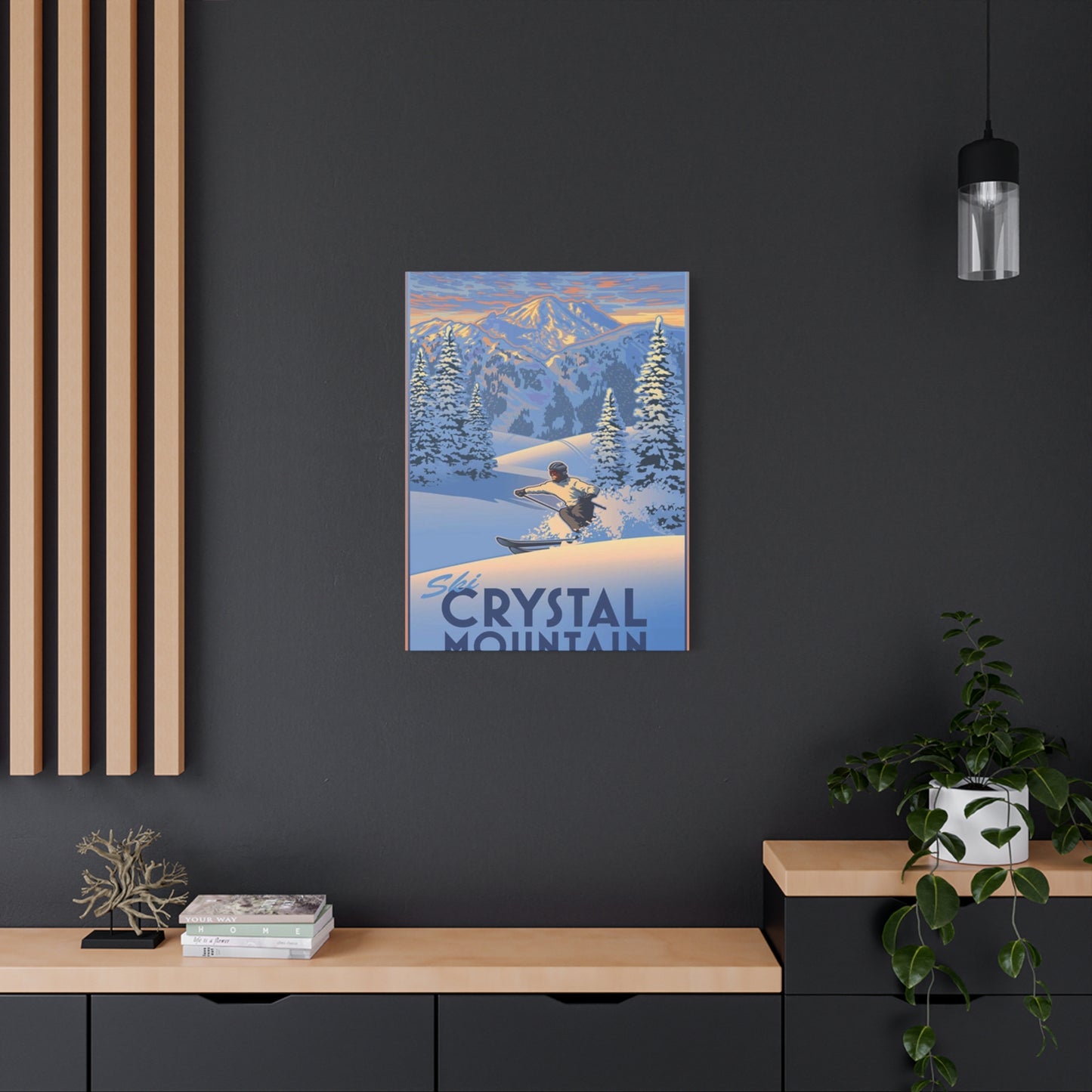Crystal Mountain Wall Art: Elevating Your Home with Natural Beauty
Crystal mountain wall art represents a captivating fusion of natural elements and artistic expression that has revolutionized how we approach home decoration. This extraordinary form of artistic display combines the raw beauty of mountainous landscapes with the mystical allure of crystalline structures, creating pieces that serve as both visual focal points and sources of positive energy within living environments.
The appeal of crystal mountain wall art extends far beyond mere aesthetic considerations. These remarkable creations offer homeowners an opportunity to bring the serenity of mountain peaks and the healing properties of crystals directly into their personal spaces. Whether crafted from genuine mineral specimens or artistically inspired by crystalline formations, these pieces have become increasingly sought after by those who appreciate the intersection of natural beauty and contemporary design.
The growing popularity of crystal mountain wall art can be attributed to several factors, including the increasing interest in mindfulness practices, the desire to create calming environments within busy modern lifestyles, and the recognition that natural elements can significantly impact our psychological well-being. As people spend more time indoors, the need to maintain a connection with nature has become more pronounced, making these artistic representations of mountain landscapes particularly relevant.
Contemporary artists and craftspeople have embraced this medium with remarkable creativity, developing techniques that capture the essence of both mountainous terrain and crystal formations. From hand-carved wooden pieces embedded with genuine gemstones to digitally printed canvases that mimic the appearance of mineral structures, the variety of approaches to crystal mountain wall art continues to expand.
The therapeutic benefits associated with crystal mountain wall art have also contributed to its rising popularity. Many individuals believe that the combination of mountain imagery and crystal elements can help create more balanced and harmonious living environments. These pieces often serve as meditation focal points, helping to establish areas of tranquility within the home where residents can retreat from the stresses of daily life.
Understanding the diverse applications and benefits of crystal mountain wall art enables homeowners to make informed decisions about incorporating these pieces into their living environments. The following sections will explore the various aspects of this fascinating art form, from traditional versus modern approaches to practical considerations for display and maintenance.
Modern vs. Traditional Crystal Mountain Art
The distinction between modern and traditional crystal mountain art reflects broader trends in contemporary design philosophy and artistic expression. Traditional approaches to this art form often emphasize the spiritual and metaphysical properties associated with both mountain imagery and crystalline structures, drawing inspiration from ancient practices and cultural beliefs that have been passed down through generations.
Traditional crystal mountain art typically incorporates authentic mineral specimens collected from various geographical locations, with artists carefully selecting stones based on their supposed healing properties and spiritual significance. These pieces often feature earth-tone color palettes that reflect the natural hues found in mountain environments, including deep browns, muted grays, and subtle greens that evoke the feeling of standing among towering peaks.
The craftsmanship involved in traditional crystal mountain art frequently emphasizes hand-made techniques that require considerable skill and patience. Artisans may spend months carefully carving wooden bases to accommodate specific crystal formations, ensuring that each piece maintains a natural appearance that honors the inherent beauty of both the mountain landscape and the mineral specimens being incorporated.
Traditional designs often incorporate symbolic elements that carry cultural or spiritual meaning, such as the use of specific crystal types believed to promote certain qualities like clarity, protection, or emotional healing. The arrangement of these elements within mountain-themed compositions follows principles that have been developed over centuries of artistic and spiritual practice.
Modern interpretations of crystal mountain wall art, by contrast, tend to emphasize contemporary aesthetic principles while maintaining the essential appeal of combining mountain imagery with crystalline elements. Modern artists often experiment with innovative materials and techniques that allow for greater flexibility in design execution, including the use of synthetic crystals, digital printing technologies, and contemporary framing methods.
The color palettes employed in modern crystal mountain art frequently incorporate bolder hues and more dramatic contrasts than their traditional counterparts. Artists may use vivid blues to represent pristine mountain lakes, brilliant whites to capture snow-capped peaks, or even abstract color combinations that convey the emotional impact of mountain experiences rather than literal representations.
Modern crystal mountain art often incorporates geometric patterns and stylized representations that appeal to contemporary design sensibilities. These pieces may feature clean lines, minimalist compositions, and sophisticated color schemes that complement modern architectural elements and contemporary furniture styles.
The integration of technology in modern crystal mountain art has opened new possibilities for artistic expression. Some contemporary pieces incorporate LED lighting systems that illuminate crystal elements or create dynamic visual effects that change throughout the day. Others may include digital components that display rotating mountain imagery or interactive elements that respond to environmental conditions.
The choice between modern and traditional crystal mountain art ultimately depends on individual preferences and the overall design aesthetic of the intended environment. Traditional pieces tend to work well in settings that emphasize natural materials, earth-tone color schemes, and organic design elements. Modern interpretations may be more suitable for contemporary environments that feature clean lines, neutral color palettes, and minimalist design principles.
Both approaches offer unique advantages and can be equally effective in creating compelling visual displays that enhance the overall atmosphere of living environments. The key is selecting pieces that resonate with personal preferences while complementing existing design elements within the home.
Crystal Mountain Wall Art for Meditation Environments
The incorporation of crystal mountain wall art into meditation environments represents a thoughtful approach to creating dedicated spaces for contemplation and spiritual practice. These carefully curated areas benefit significantly from the presence of artistic elements that promote tranquility while maintaining visual interest without becoming distracting or overwhelming.
Meditation environments require careful consideration of all visual elements, as these components directly influence the practitioner's ability to achieve focused states of consciousness. Crystal mountain wall art offers an ideal solution for this challenge, providing visual anchors that support meditative practices while contributing to the overall atmosphere of serenity and connection with natural elements.
The selection of appropriate crystal mountain wall art for meditation environments involves understanding how different visual elements affect consciousness and emotional states. Mountain imagery naturally evokes feelings of stability, permanence, and connection with larger natural forces, while crystal elements add layers of meaning related to clarity, purification, and spiritual awareness.
Color considerations play a crucial role when selecting crystal mountain wall art for meditation environments. Cooler tones such as blues and purples tend to promote calm and introspective states, making them particularly suitable for contemplative practices. Warmer colors like oranges and reds may be appropriate for more active forms of meditation or when the goal is to enhance energy levels rather than promote relaxation.
The size and placement of crystal mountain wall art within meditation environments requires careful planning to ensure that these pieces enhance rather than dominate the available visual field. Oversized pieces may become overwhelming during extended meditation sessions, while pieces that are too small may fail to provide adequate visual support for focusing practices.
Lighting considerations significantly impact how crystal mountain wall art appears within meditation environments. Natural lighting tends to highlight the subtle variations in texture and color that make these pieces particularly compelling, while artificial lighting can be adjusted to create specific moods or emphasize particular elements within the composition.
The positioning of crystal mountain wall art relative to meditation seating areas influences how practitioners interact with these visual elements during their practice. Pieces placed directly in front of meditation seating may serve as focal points for concentration techniques, while artwork positioned to the sides or behind seating areas can provide ambient visual support without demanding direct attention.
Creating layered visual compositions using multiple pieces of crystal mountain wall art can enhance the meditative quality of dedicated practice areas. This approach involves carefully arranging pieces of varying sizes and visual weights to create balanced compositions that support extended periods of contemplation without becoming visually repetitive or monotonous.
The integration of actual crystal specimens with mountain-themed artwork can create particularly powerful meditation focal points. These combinations allow practitioners to benefit from both the visual impact of artistic representations and the supposed energetic properties of genuine mineral specimens, creating multi-layered experiences that engage different aspects of consciousness.
Regular maintenance of crystal mountain wall art in meditation environments helps preserve both the physical appearance and the energetic qualities that make these pieces valuable components of spiritual practice areas. This maintenance may include gentle cleaning of crystal elements, ensuring proper lighting conditions, and occasionally rearranging pieces to maintain visual freshness and prevent habituation.
The psychological benefits of incorporating crystal mountain wall art into meditation environments extend beyond immediate practice sessions. These visual elements help establish clear boundaries between everyday living areas and dedicated spaces for spiritual development, supporting the mental transitions necessary for effective meditation practice.
Materials Used in Crystal Mountain Wall Art
The selection of materials used in crystal mountain wall art significantly influences both the aesthetic appeal and the energetic properties of finished pieces. Artists and craftspeople working in this medium have access to an extensive range of natural and synthetic materials, each offering unique characteristics that contribute to the overall impact of completed works.
Genuine crystal specimens represent the most traditional and highly valued materials used in crystal mountain wall art. These authentic mineral formations offer unique visual properties including natural color variations, internal structural patterns, and light-refracting qualities that cannot be replicated through artificial means. The selection of specific crystal types often depends on both aesthetic considerations and the supposed metaphysical properties associated with different mineral varieties.
Quartz crystals in their various forms constitute one of the most popular categories of materials for crystal mountain wall art. Clear quartz offers exceptional light-transmitting properties that can create dramatic visual effects when properly illuminated, while colored quartz varieties such as amethyst, citrine, and rose quartz provide specific color accents that can be coordinated with mountain imagery and overall design schemes.
Semi-precious gemstones including agate, jasper, and turquoise are frequently incorporated into crystal mountain wall art due to their durability and attractive appearance. These materials often feature natural patterns and color variations that complement mountain imagery, creating cohesive compositions that celebrate the beauty of natural formations found in various geographical environments.
Synthetic crystal materials have become increasingly sophisticated and offer several practical advantages over genuine specimens. These manufactured alternatives can be produced in specific colors, sizes, and shapes that may be difficult or impossible to obtain using natural materials. Additionally, synthetic crystals often cost significantly less than genuine specimens while providing comparable visual impact.
Wood serves as a fundamental base material for many crystal mountain wall art pieces, providing structural support while contributing natural textures and colors that complement both crystal elements and mountain imagery. Different wood species offer varying grain patterns, colors, and working properties that allow artists to select materials that best support their specific design intentions.
Metal components including copper, brass, and silver may be incorporated into crystal mountain wall art to create mounting systems, decorative accents, or structural elements that enhance the overall composition. These materials can be treated with various finishes to achieve specific colors or textures that coordinate with other elements within the piece.
Canvas and fabric materials serve as foundations for printed or painted mountain imagery that forms the backdrop for crystal elements. The selection of appropriate canvas materials influences both the appearance and longevity of finished pieces, with factors such as thread count, fiber composition, and surface treatments affecting how colors appear and how well the material resists fading over time.
Glass elements may be incorporated into crystal mountain wall art to create light-transmitting effects or to provide protective covering for delicate components. Different types of glass offer varying levels of clarity, color, and optical properties that can be selected to enhance specific design elements within the overall composition.
Resin materials allow artists to create custom crystal-like elements that can be shaped, colored, and finished to meet specific design requirements. These synthetic alternatives provide greater flexibility in terms of size, shape, and color while maintaining visual characteristics that complement genuine crystal specimens.
Stone materials including marble, granite, and slate can provide substantial base elements for crystal mountain wall art while contributing natural textures and colors that reinforce the connection with geological formations. These materials offer exceptional durability and can be shaped using traditional stone-working techniques to create custom mounting systems and decorative elements.
The combination of multiple materials within single pieces of crystal mountain wall art allows artists to create complex compositions that engage viewers on multiple sensory levels. Successful material combinations require careful consideration of how different textures, colors, and light-reflecting properties interact to create cohesive visual experiences.
Quality considerations when selecting materials for crystal mountain wall art include durability, color stability, and compatibility with intended display environments. Materials that will be exposed to direct sunlight require special attention to fade resistance, while pieces intended for high-humidity environments need materials that can withstand moisture exposure without degradation.
Crystal Mountain Art and Feng Shui
The application of Feng Shui principles to crystal mountain wall art creates opportunities to enhance the energetic qualities of living environments while maintaining aesthetic appeal. This ancient Chinese practice provides specific guidelines for the placement and selection of decorative elements based on their supposed ability to influence the flow of energy within architectural environments.
According to Feng Shui philosophy, crystal mountain wall art can serve multiple functions within residential and commercial environments. The mountain imagery provides symbolic representation of stability, support, and protection, while crystal elements contribute qualities related to clarity, purification, and energetic amplification. The combination of these elements creates compositions that supposedly promote both physical comfort and spiritual well-being.
The positioning of crystal mountain wall art according to Feng Shui principles involves careful consideration of compass directions and their associated elemental qualities. Mountain imagery is traditionally associated with earth energy, making these pieces particularly suitable for placement in areas that benefit from enhanced stability and grounding influences. Crystal elements may be associated with different elemental qualities depending on their specific composition and color characteristics.
Color selection for crystal mountain wall art intended for Feng Shui applications requires understanding how different hues relate to specific areas of life according to traditional Chinese philosophy. Earth tones including browns, yellows, and oranges are believed to enhance stability and material prosperity, while cooler colors such as blues and purples may promote spiritual development and emotional balance.
The size and visual weight of crystal mountain wall art pieces influences their effectiveness within Feng Shui applications. Larger pieces are believed to provide stronger energetic influences but may overwhelm smaller environments, while smaller pieces may be insufficient to create desired effects in larger areas. Finding appropriate balance requires careful consideration of room proportions and intended outcomes.
Feng Shui practitioners often recommend specific crystal types for inclusion in mountain-themed artwork based on their supposed metaphysical properties. Clear quartz is believed to provide general energetic amplification, while specific colored crystals may be selected to address particular areas of concern or to enhance specific life aspects such as relationships, career development, or health maintenance.
The arrangement of multiple crystal mountain wall art pieces within single environments follows Feng Shui principles related to energy flow and visual balance. These guidelines suggest avoiding symmetrical arrangements that may create stagnant energy patterns while ensuring that pieces are distributed in ways that promote smooth energy circulation throughout the available area.
Lighting considerations play important roles in Feng Shui applications of crystal mountain wall art. Natural lighting is generally preferred as it provides full-spectrum illumination that supposedly enhances the energetic properties of both crystal elements and mountain imagery. Artificial lighting should be selected to complement rather than overwhelm the natural qualities of these artistic compositions.
The integration of crystal mountain wall art with other Feng Shui elements including plants, water features, and specific furniture arrangements can create comprehensive environmental designs that address multiple aspects of energy flow and environmental harmony. These integrated approaches require careful planning to ensure that all elements work together effectively.
Maintenance practices for crystal mountain wall art used in Feng Shui applications may include regular cleaning rituals designed to preserve and enhance the supposed energetic properties of these pieces. These practices might involve specific cleaning materials, timing considerations, and intention-setting activities that go beyond basic physical maintenance requirements.
The seasonal rotation or adjustment of crystal mountain wall art according to Feng Shui principles can help maintain energetic freshness and address changing environmental needs throughout the year. These adjustments might involve changing lighting conditions, repositioning pieces, or temporarily replacing certain elements to maintain optimal energy flow.
Personal intention and mindful interaction with crystal mountain wall art enhances its effectiveness within Feng Shui applications. Practitioners are often encouraged to spend time consciously appreciating these pieces and setting specific intentions for the types of experiences or outcomes they hope to cultivate within their living environments.
The combination of traditional Feng Shui principles with contemporary understanding of environmental psychology suggests that crystal mountain wall art can indeed influence mood, stress levels, and overall well-being through both symbolic associations and direct sensory impact. This dual approach validates both traditional wisdom and modern scientific understanding of how environmental factors affect human experience.
Enhancing Living Rooms with Crystal Mountain Pieces
The integration of crystal mountain wall art into living room environments offers numerous opportunities to create focal points that enhance both aesthetic appeal and atmospheric quality. These social areas benefit particularly from decorative elements that promote conversation while contributing to overall environmental comfort and visual interest.
Living rooms present unique challenges and opportunities for crystal mountain wall art placement due to their multifunctional nature and the variety of activities that typically occur within these environments. Successful integration requires consideration of sight lines from multiple seating positions, lighting conditions throughout different times of day, and the need to maintain visual interest without creating distraction during various activities.
The scale of crystal mountain wall art appropriate for living room applications depends largely on the overall size and proportions of the available area. Larger living rooms can accommodate substantial pieces that serve as dramatic focal points, while smaller areas may benefit from carefully selected smaller pieces that provide visual interest without overwhelming the available visual field.
Color coordination between crystal mountain wall art and existing living room design elements requires careful consideration of both permanent architectural features and changeable decorative components. These pieces should complement rather than compete with existing color schemes while providing sufficient contrast to maintain visual interest and prevent the artwork from disappearing into the background.
The positioning of crystal mountain wall art relative to seating arrangements influences how occupants experience these pieces during various activities. Artwork placed behind seating areas may provide ambient visual support, while pieces positioned within direct sight lines from primary seating can serve as conversation focal points or meditation anchors during quieter moments.
Lighting design plays a crucial role in maximizing the visual impact of crystal mountain wall art within living room environments. Natural lighting from windows can create dynamic visual effects throughout the day as the angle and intensity of illumination changes, while artificial lighting systems can be designed to highlight specific elements or create particular moods during evening hours.
The combination of crystal mountain wall art with other decorative elements within living rooms requires careful attention to visual balance and thematic consistency. These pieces work particularly well when combined with other natural elements such as plants, natural fiber textiles, or furniture constructed from organic materials that reinforce the connection with natural environments.
Seasonal adjustments to crystal mountain wall art displays can help maintain visual freshness and provide opportunities to adapt living room atmospheres to changing weather conditions and holiday celebrations. These modifications might involve changing accent lighting, adding seasonal decorative elements, or temporarily repositioning pieces to create new visual relationships.
The maintenance requirements for crystal mountain wall art in living room environments include regular dusting to preserve visual clarity and occasional deeper cleaning to maintain the energetic qualities associated with crystal elements. These maintenance activities can be incorporated into regular housekeeping routines to ensure that pieces continue to provide optimal visual and atmospheric benefits.
The psychological benefits of crystal mountain wall art in living rooms extend beyond immediate aesthetic appreciation. These pieces can help create more relaxing environments that promote stress reduction and emotional well-being, contributing to the overall quality of life for residents and their guests.
Storage and protection considerations for crystal mountain wall art in living rooms may include planning for temporary removal during large gatherings or parties where increased activity levels might pose risks to delicate elements. Removable mounting systems can provide flexibility while maintaining security during normal use periods.
The investment value of quality crystal mountain wall art makes these pieces particularly suitable for living room applications where they will be regularly viewed and appreciated by both residents and visitors. Well-selected pieces can provide years of visual enjoyment while potentially increasing in value over time.
The educational opportunities provided by crystal mountain wall art in living rooms can spark conversations about geology, geography, and artistic techniques while providing natural starting points for discussions about environmental awareness and appreciation of natural beauty.
The Rise of Geometric Crystal Mountain Art
Contemporary artists working with crystal mountain wall art have increasingly embraced geometric design principles that bring fresh perspectives to traditional mountain and crystal imagery. This evolution reflects broader trends in contemporary art and design that emphasize mathematical relationships, systematic compositions, and the intersection between natural forms and human organizational systems.
Geometric approaches to crystal mountain wall art often involve abstracting natural mountain forms into simplified shapes that emphasize essential structural relationships while eliminating unnecessary details that might distract from overall compositional impact. These simplified representations can be more versatile in terms of integration with contemporary architectural environments while maintaining the essential emotional and symbolic content associated with mountain imagery.
The mathematical principles underlying geometric crystal mountain art provide frameworks for creating compositions that feel balanced and harmonious even when incorporating complex arrangements of multiple elements. These principles draw from established design traditions including the golden ratio, symmetrical relationships, and proportional systems that have been recognized for their aesthetic appeal across multiple cultures and time periods.
Color applications in geometric crystal mountain art often emphasize systematic relationships between hues, values, and saturation levels that create coherent visual experiences while allowing for considerable creative flexibility. These systematic approaches to color selection can help ensure that finished pieces integrate effectively with existing environmental color schemes while maintaining sufficient visual impact to serve as compelling focal points.
The use of repeated geometric patterns within crystal mountain wall art can create visual rhythms that engage viewers on multiple levels while providing organizational structures that help unify complex compositions. These patterns may reference traditional decorative motifs from various cultures while incorporating contemporary sensibilities that appeal to modern aesthetic preferences.
Angular geometric forms can be particularly effective at representing the structural qualities of both mountain formations and crystal structures, as both natural phenomena exhibit geometric relationships that can be emphasized through artistic interpretation. These angular elements can create dynamic visual energy while maintaining the stability and permanence associated with mountain symbolism.
The integration of geometric crystal mountain art with contemporary architectural elements including clean-lined furniture, minimalist color schemes, and sophisticated lighting systems requires careful attention to scale, proportion, and visual weight to ensure successful environmental integration. These pieces should complement rather than compete with existing design elements while providing sufficient contrast to maintain visual interest.
Technology applications in geometric crystal mountain art have expanded creative possibilities through computer-aided design systems, precision cutting tools, and digital printing technologies that allow for extremely accurate execution of complex geometric relationships. These technological capabilities enable artists to realize design concepts that would be difficult or impossible to execute using traditional hand-crafting techniques alone.
The symbolic content of geometric crystal mountain art may emphasize different aspects of mountain and crystal symbolism compared to more naturalistic representations. Geometric interpretations often highlight structural relationships, mathematical harmony, and the underlying organizational principles that govern natural phenomena rather than focusing primarily on surface appearances or emotional associations.
Market acceptance of geometric crystal mountain art reflects growing appreciation for design approaches that successfully bridge traditional artistic content with contemporary aesthetic sensibilities. These pieces appeal to collectors and homeowners who appreciate both natural symbolism and sophisticated design execution, creating broad market appeal across multiple demographic categories.
The educational value of geometric crystal mountain art includes opportunities to explore mathematical relationships found in natural formations while appreciating artistic techniques that transform these mathematical principles into visually compelling compositions. These educational aspects can add layers of meaning and interest that enhance long-term appreciation of individual pieces.
Customization opportunities in geometric crystal mountain art are often enhanced by the systematic nature of geometric design approaches, which can be more easily modified to accommodate specific size requirements, color preferences, or environmental considerations than more organic artistic approaches that rely heavily on intuitive compositional decisions.
The durability advantages of geometric crystal mountain art may include reduced complexity in terms of structural requirements and maintenance needs compared to pieces that incorporate irregular natural forms or delicate realistic details that require more careful handling and preservation techniques.
Crystal Mountain Wall Art as Statement Pieces
The concept of crystal mountain wall art as statement pieces involves selecting and displaying these works in ways that establish them as primary focal points within their environments. Statement pieces are characterized by their ability to immediately capture attention while conveying specific messages about the occupants' aesthetic preferences, lifestyle choices, and personal values.
Effective statement pieces of crystal mountain wall art typically possess certain characteristics that distinguish them from more subtle decorative elements. These characteristics may include substantial size that commands visual attention, exceptional craftsmanship that rewards close examination, unique design elements that set them apart from mass-produced alternatives, or particularly striking combinations of materials that create memorable visual impact.
The positioning of crystal mountain wall art statement pieces requires careful consideration of architectural features, traffic patterns, and sight lines to ensure maximum visual impact while maintaining appropriate relationships with other environmental elements. Statement pieces often benefit from dedicated wall areas that provide sufficient visual breathing room to prevent competing visual elements from diminishing their impact.
Lighting design becomes particularly important when crystal mountain wall art serves as statement pieces, as proper illumination can dramatically enhance the visual properties that make these works compelling focal points. Statement pieces may justify investment in specialized lighting systems including track lighting, picture lighting, or architectural lighting features that provide optimal illumination while contributing to overall environmental ambiance.
The selection of crystal mountain wall art statement pieces should reflect careful consideration of long-term satisfaction, as these prominent positions within living environments make it important to choose works that will continue to provide visual and emotional satisfaction over extended periods. Statement pieces represent significant investments in both financial and aesthetic terms, making quality and personal resonance crucial selection criteria.
Color relationships between crystal mountain wall art statement pieces and their surrounding environments require careful planning to ensure that these focal points enhance rather than clash with existing design schemes. Statement pieces may either harmonize closely with environmental colors to create sophisticated tonal relationships or provide dramatic contrasts that energize neutral backgrounds through strategic color placement.
The scale considerations for crystal mountain wall art statement pieces involve balancing visual impact with environmental appropriateness to create commanding presence without overwhelming available areas or creating uncomfortable visual relationships. Proper scale selection helps ensure that statement pieces enhance rather than dominate their environments while providing appropriate visual weight for their intended focal point roles.
Thematic consistency between crystal mountain wall art statement pieces and overall environmental design concepts helps create cohesive living environments that feel intentionally designed rather than accidentally assembled. Statement pieces should support and enhance broader design themes while providing sufficient individuality to justify their prominent positions within the overall composition.
The investment considerations for crystal mountain wall art statement pieces include both initial acquisition costs and long-term value retention, as these prominent pieces often represent substantial financial commitments that should be evaluated from both aesthetic and economic perspectives. Quality statement pieces may appreciate in value over time while providing ongoing aesthetic and emotional benefits.
Maintenance requirements for crystal mountain wall art statement pieces may be more demanding than those for smaller or less prominent decorative elements, as their focal point positions make any deterioration or damage immediately apparent to occupants and visitors. Regular maintenance schedules help preserve both appearance and investment value while ensuring continued aesthetic satisfaction.
The psychological impact of crystal mountain wall art statement pieces extends beyond immediate visual appreciation to include influences on mood, stress levels, and overall environmental satisfaction. These prominent pieces can significantly affect how occupants and visitors experience entire rooms or living areas, making their selection and placement important considerations for overall environmental quality.
The conversation-starting potential of crystal mountain wall art statement pieces adds social dimensions to their aesthetic functions, as these prominent works often become topics of discussion that reveal interests, experiences, and values while providing natural starting points for meaningful conversations between occupants and their guests.
The flexibility considerations for crystal mountain wall art statement pieces involve planning for potential future changes in environmental design, living situations, or personal preferences that might affect the appropriateness of specific pieces or their current positions within living environments.
Layering Textures in Crystal Mountain Designs
The artistic technique of layering textures within crystal mountain wall art creates visual depth and tactile interest that enhances the overall sensory impact of these decorative pieces. This approach involves combining multiple surface qualities, material characteristics, and visual treatments to create complex compositions that reward both distant viewing and close examination.
Texture layering in crystal mountain wall art begins with understanding how different materials contribute unique surface qualities that can be combined effectively. Natural crystal specimens provide inherent textural variety through their crystalline structures, surface irregularities, and light-reflecting properties, while background materials such as wood, canvas, or metal contribute additional textural dimensions that can complement or contrast with crystal elements.
The visual hierarchy established through texture layering helps guide viewer attention through complex compositions while maintaining overall unity and coherence. Dominant textures typically occupy primary positions within compositions, while secondary and tertiary textural elements provide supporting visual interest without competing for primary attention. This hierarchical approach prevents textural complexity from becoming overwhelming or visually chaotic.
Contrast relationships between different textural elements create visual excitement and dynamic interest that can make crystal mountain wall art more engaging over extended viewing periods. Smooth polished crystal surfaces may be contrasted with rough natural stone textures, while organic wood grains might be juxtaposed with precise geometric patterns to create tension and resolution within overall compositions.
The scale considerations in texture layering involve coordinating the relative sizes of different textural elements to create appropriate visual relationships that maintain legibility and impact at intended viewing distances. Large-scale textures provide bold visual statements that remain apparent from distant viewing positions, while fine textures reward close examination and add layers of interest for viewers who spend extended time with individual pieces.
Color interactions between different textural layers require careful consideration to ensure that surface variations enhance rather than compete with overall color schemes. Textural elements may either reinforce existing color relationships through similar hue selections or provide subtle contrast through varied surface treatments that affect how colors appear under different lighting conditions.
Light interaction with layered textures creates dynamic visual effects that change throughout the day as illumination angles and intensities vary. Textural elements that catch and reflect light differently can create temporal visual interest that prevents pieces from becoming static or monotonous, while shadows cast by raised textural elements add additional depth and complexity to overall compositions.
The integration of natural and artificial textural elements allows artists to combine the unpredictable beauty of natural formations with the precision and control available through manufactured materials and processes. This combination can create compositions that celebrate both organic beauty and human craftsmanship while providing flexibility in terms of design execution and customization possibilities.
Tool selection for creating textural effects in crystal mountain wall art includes both traditional hand tools that provide organic irregularity and precision instruments that allow for controlled surface treatments. The choice of appropriate tools depends on intended textural effects, material characteristics, and desired levels of precision or irregularity within finished compositions.
The maintenance implications of heavily textured crystal mountain wall art include considerations for dust accumulation in surface irregularities, potential damage to delicate textural elements, and access requirements for cleaning complex surface areas. Planning for maintenance needs during the design phase can help ensure that textural complexity does not create ongoing care burdens that detract from long-term satisfaction.
The photographic documentation of textured crystal mountain wall art presents unique challenges due to the difficulty of capturing three-dimensional surface qualities in two-dimensional images. Proper lighting and photographic techniques become important for accurately representing textural qualities for promotional, archival, or insurance documentation purposes.
The tactile qualities of textured crystal mountain wall art add sensory dimensions beyond visual appreciation, creating opportunities for physical interaction that can enhance emotional connections with individual pieces. The invitation to touch and explore textural surfaces can create more intimate relationships between viewers and artwork while adding layers of sensory experience.
The cost implications of complex texture layering may include increased material requirements, extended fabrication time, and specialized tools or techniques that affect overall project budgets. Understanding these cost factors helps ensure that textural complexity remains within practical limits while achieving desired aesthetic outcomes.
Display Tips for Crystal Mountain Wall Art
Effective display of crystal mountain wall art requires careful attention to numerous factors that influence both visual impact and long-term preservation of these decorative pieces. Proper display techniques can significantly enhance the aesthetic value of individual works while ensuring their continued beauty and structural integrity over extended periods.
Wall selection for crystal mountain wall art involves evaluating structural considerations including wall strength, stud locations, and mounting hardware requirements to ensure secure installation that can safely support the weight of individual pieces. Additionally, wall surface characteristics such as texture, color, and existing damage must be assessed to determine appropriate mounting methods and any necessary surface preparation.
The height considerations for crystal mountain wall art placement typically follow standard guidelines that position the center of artwork approximately 57-60 inches from the floor, though these guidelines may require adjustment based on ceiling height, furniture placement, and intended viewing positions. Proper height placement ensures comfortable viewing angles while maintaining appropriate visual relationships with surrounding environmental elements.
Lighting angles significantly affect how crystal mountain wall art appears under various conditions, with grazing light angles revealing textural details while perpendicular illumination may minimize surface variations. Understanding these lighting relationships allows for strategic positioning that maximizes visual impact during peak viewing periods while avoiding harsh shadows or glare that might detract from aesthetic appreciation.
The spacing considerations when displaying multiple crystal mountain wall art pieces involve maintaining appropriate visual relationships between individual works while preventing overcrowding that might diminish the impact of each piece. General guidelines suggest maintaining distances between pieces equal to approximately one-quarter to one-half the width of individual works, though these proportions may require adjustment based on piece sizes and wall dimensions.
Environmental factors including humidity levels, temperature fluctuations, and air circulation patterns can significantly affect crystal mountain wall art over time, particularly pieces that incorporate organic materials such as wood or natural fibers. Display locations should be selected to minimize exposure to extreme conditions while maintaining appropriate environmental stability.
Security considerations for valuable crystal mountain wall art may include specialized mounting systems, alarm integration, or positioning away from high-traffic areas where accidental damage might occur. These security measures should be planned to provide adequate protection without interfering with aesthetic appreciation or creating obvious indications of valuable content.
The integration of crystal mountain wall art with existing furniture and decorative elements requires careful attention to visual weight, color relationships, and style compatibility to create harmonious environmental compositions. Successful integration involves coordinating new artwork with existing elements while allowing each component to contribute effectively to overall design schemes.
Seasonal adjustments to crystal mountain wall art displays can help maintain visual freshness and adapt environmental atmospheres to changing weather conditions and holiday celebrations. These adjustments might involve changing accent lighting, repositioning pieces to take advantage of seasonal light patterns, or adding temporary decorative elements that enhance seasonal themes.
Protection measures for crystal mountain wall art include consideration of factors such as direct sunlight exposure that might cause fading, high-traffic areas where physical damage might occur, and environmental conditions that could cause deterioration over time. Proper protection planning helps ensure long-term preservation while maintaining accessibility for viewing and appreciation.
The documentation of crystal mountain wall art installations includes recording mounting methods, hardware specifications, and installation dates for future reference during maintenance, insurance claims, or relocation activities. Proper documentation helps ensure that installations can be safely modified or reproduced as needed while maintaining appropriate care standards.
Professional installation services may be advisable for particularly valuable or complex crystal mountain wall art pieces that require specialized mounting techniques, electrical connections for integrated lighting, or precise positioning for optimal visual impact. Professional installers can provide expertise and insurance coverage that may not be available through amateur installation attempts.
The evaluation of display effectiveness involves periodic assessment of visual impact, structural integrity, and environmental appropriateness to ensure that crystal mountain wall art continues to provide optimal aesthetic and functional benefits. Regular evaluation allows for timely adjustments that can address changing conditions or preferences before problems become significant issues.
Custom Crystal Mountain Wall Art Ideas
The creation of custom crystal mountain wall art offers unlimited opportunities to develop unique pieces that perfectly reflect personal preferences, environmental requirements, and specific design objectives. Custom approaches allow for complete control over all aspects of composition, materials, scale, and execution while ensuring that finished pieces integrate seamlessly with intended display environments.
Personal experience integration represents one of the most meaningful approaches to custom crystal mountain wall art, incorporating elements that reference specific locations, meaningful experiences, or important life events. These personal connections can transform decorative artwork into powerful emotional anchors that provide ongoing inspiration and connection with significant memories or aspirations.
Color customization allows for precise coordination with existing environmental design schemes while maintaining the essential character and symbolic content associated with mountain and crystal imagery. Custom color selection can address specific design challenges such as coordinating with unique paint colors, architectural elements, or furniture finishes that might not be accommodated by standard commercial offerings.
Size adaptation ensures that custom crystal mountain wall art pieces fit perfectly within intended display locations while providing appropriate visual impact for their specific environments. Custom sizing eliminates the compromises often necessary when working with standard dimensions, allowing for optimal utilization of available wall areas and perfect integration with architectural features.
Material selection customization provides opportunities to incorporate specific crystal types, wood species, metal finishes, or other materials that carry personal significance or provide desired aesthetic qualities. These material choices can reference geographic origins, mineral collecting experiences, or simply aesthetic preferences that reflect individual taste and design sensibilities.
Composition flexibility in custom crystal mountain wall art allows for incorporating multiple related pieces that work together as coordinated series or for developing single large-scale pieces that serve as dramatic focal points. Custom composition planning ensures that individual pieces or series work effectively within their intended environments while providing desired visual impact and thematic consistency.
Lighting integration possibilities in custom crystal mountain wall art include incorporated LED systems, fiber optic elements, or specialized mounting systems that accommodate external lighting equipment. These lighting enhancements can dramatically increase visual impact while providing functional illumination that contributes to overall environmental ambiance.
Symbolic content customization allows for incorporating specific imagery, patterns, or elements that carry personal meaning or reference particular spiritual, cultural, or philosophical traditions. These symbolic additions can transform decorative artwork into meaningful expressions of personal beliefs, interests, or aspirations while maintaining broad aesthetic appeal.
Conclusion
Crystal mountain wall art brings together the raw elegance of nature and the awe-inspiring beauty of majestic landscapes, creating a unique and harmonious addition to any interior space. These captivating pieces not only elevate your home’s aesthetic but also foster a sense of tranquility, wonder, and grounding that few other art forms can achieve. By blending the structural brilliance of crystals with the grandeur of mountain imagery, this style of wall art invites you to reconnect with the natural world in a deeply personal and visually compelling way.
Whether you’re drawn to shimmering crystal formations embedded within painted mountain sceneries or abstract geometric designs that mimic mineral shapes and peaks, crystal mountain wall art captures a perfect balance of texture, light, and energy. These artworks speak to both the beauty of the earth and the inner peace that comes from surrounding yourself with elements that are organic, timeless, and meaningful.
One of the greatest advantages of incorporating crystal mountain wall art into your home is its versatility. It seamlessly fits into a wide range of interior design styles—from modern and minimalist to rustic, bohemian, and earthy aesthetics. Whether used as a large focal point in a living room or bedroom, or as part of a curated gallery wall, these pieces serve as both conversation starters and quiet reminders of nature’s enduring elegance.
Beyond aesthetics, crystal mountain art carries symbolic significance. Mountains represent strength, stability, and spiritual ascent, while crystals are often associated with healing, clarity, and energy alignment. Together, they create a powerful visual metaphor for growth, resilience, and balance. Hanging such artwork in your home can help cultivate a calming atmosphere, ideal for relaxation, meditation, or simply unwinding after a long day.
Additionally, these artworks often blend rich color palettes—such as deep blues, silvery grays, amethysts, and natural earth tones—bringing depth and richness to your walls. Some pieces even incorporate materials like metallic foils, textured paints, or resin to reflect light and mimic the luminous quality of real crystals, adding dimension and visual interest to your space.
In conclusion, crystal mountain wall art is more than just decoration—it is an invitation to bring the power and serenity of the natural world into your home. It celebrates the connection between the physical and spiritual, the grounded and the ethereal. Whether you’re a nature lover, a design enthusiast, or someone seeking a peaceful ambiance, these artworks offer a stunning way to elevate your environment. Embrace the harmony of earth and art, and let crystal mountain wall art transform your space into a sanctuary of natural beauty.

















